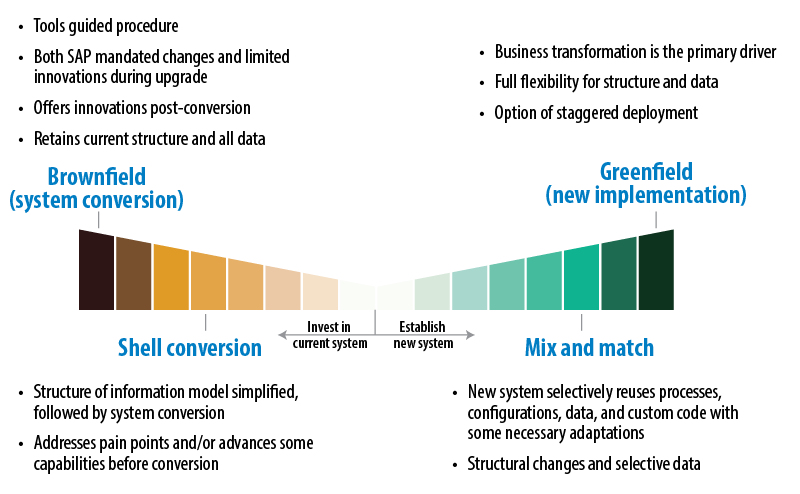Insights
Moving to S/4HANA is an enormous project. However, companies can take specific steps to ensure the transition is less disruptive — often with a combination of strategic planning and advanced tools.
- Organizations must evaluate the impact of this conversion on their business processes, technology infrastructure, custom code, and user experience.
- Companies must decide if they need an entirely new ERP system or only want to make technical upgrades to their current software.
- The three main approaches to an S/4HANA implementation are greenfield, brownfield, and hybrid — each with its own benefits and challenges.
- Brownfield:
- For companies that have relatively new ERP systems that still function effectively, but they want to upgrade to S/4HANA to realize the full potential of AI, machine learning, internet of things, and other new technologies and functionalities
- Greenfield
- Firms generally take this route if their existing system is archaic across the board. In a greenfield approach, the entire process design is restructured to meet a company’s latest business needs
- Hybrid
- For organizations that want to reuse existing ERP processes that work well for them but still take advantage of the new capabilities of S/4HANA for the rest
- Organizations that involve both the business and technology sides early in the transformation can minimize the impact of change management.
Large, successful companies are investing aggressively in new technology, but they are often at a loss when deciding whether and how to upgrade their enterprise resource planning (ERP) systems. This software has usually been customized over years or decades to fit a company’s specific needs and ways of working. Even with such built-in advantages, these dated systems are not agile enough to adjust to the changing demands of the workplace and marketplace.
Business executives say they want new ERPs so they can benefit from the embedded analytics, flexible systems, and better user experiences. That mirrors another technology trend in which organizations are focused less on efficiency and more on growth and innovation — initiatives possible only with more modern systems. A recent Infosys survey found that companies are pursuing digital transformation to better innovate, create new business models, engage customers, and develop a data culture.1
For these reasons, 73% of SAP customers say they plan to upgrade to S/4HANA and 54% expect to do so in the next three years, according to an IDC survey conducted for SAP. Many see S/4HANA as a part of their larger plan to modernize their digital infrastructure and move to the cloud, two of the most dominant technology trends of the past two years.2
However, the switch to S/4HANA requires a huge commitment of time and money (often millions of dollars). Movement to this cloud-based system can take from seven months to three years based on the migration approach, the landscape, and the size of the organization — among other factors. Moreover, it can require significant change management. Executives fear they may leave behind the system that worked well for years and contributed to their success.
Figure 1. Factors to understand before deciding how to switch to S/4HANA

Source: Infosys
Three ways to switch to S/4HANA
When planning an S/4HANA migration, organizations need to identify their technical and business needs for moving. Some companies find that too much custom code and redundancy has accumulated over the years, making an upgrade necessary. Others might be happy with the existing setup but want to move to S/4HANA to grow their digital capabilities, such as embedded artificial intelligence (AI,) analytics, and intelligent process automation. Yet others might find that most of their current processes work very well and differentiate them from competitors, and that few of their processes need to be simplified (see Figure 1).
When companies decide to update their ERP, they must also choose how to go about tackling this massive project. Their path is influenced by the existing IT infrastructure, prevailing industry conditions, and cost-benefit calculations. Companies must decide if they need an entirely new ERP system or only want to make technical upgrades to their current software. The three main approaches to an S/4HANA implementation are greenfield, brownfield, and hybrid — each with its own benefits and challenges.
Greenfield
In a greenfield approach, the entire process design is restructured to meet a company’s latest business needs, so firms generally take this route if their existing system is archaic across the board. For example, a retailer’s 20-year-old ERP system would not support the current needs for omnichannel commerce, data analytics, and digital supply chain management. Most companies in that situation find it is more effective to completely overhaul their system instead of adding bits and pieces of supporting software.
Greenfield approach is recommended for companies experimenting with new business lines
Greenfield is also the best approach when organizations acquire companies with incompatible processes and systems. These mergers create great complexity, such as when a European renewable energy company merged with a leading engineering company. The combined organization owned 22 manufacturing plants worldwide but had no standardization across business and IT processes and systems. The new company used 12 legacy ERP applications, including 10 different SAP instances and 1,300 peripheral applications. The company partnered with Infosys and decided to use a greenfield approach to implement S/4HANA to consolidate its ERP landscape. This implementation reduced process complexity by 40% and led to a 20% cost savings on IT infrastructure.
This simplification also creates new complexity, though. Many of a company’s current ERP processes are not supported in the updated system, so business users have to be retrained in the new processes that S/4HANA requires. Extensive testing is also needed to ensure that the new processes work. Depending on the size of the implementation, the greenfield approach can take one to three years — a long wait when technology is evolving so rapidly.
Brownfield
Many organizations have relatively new ERP systems that still function effectively, but they want to upgrade to S/4HANA to realize the full potential of AI, machine learning, internet of things, and other new technologies and functionalities. In these cases, brownfield is the best option. Companies can also convert custom code developed in their legacy systems to reuse in S/4HANA.
This tools-based approach changes the underlying core from SAP’s ERP Central Component (ECC) to S/4HANA with minimal changes to functions and business processes. Initially, the original code base — especially custom code — is examined to identify parts that might not be compatible with S/4HANA. Then, these disparities are fixed to make the code compatible with the new system.
Afterward, all the data is converted and migrated to the HANA database. Although this is a massive job, automation tools can speed up the process and reduce the effort needed. Infosys’ proprietary HANA CMO tool can automate from 60% to 80% of custom code remediation. This brownfield approach is less expensive and takes eight to 14 months, compared with the 15 to 24 months required for one phase of greenfield implementation. Another advantage is that most business processes remain the same, so there is little disturbance to the day-to-day business. The change management required is minimal since users do not have to undergo intensive retraining.
HANA (Infosys’ proprietary) CMO tool can automate from 60% to 80% of custom code remediation
Hybrid: Best of both worlds
Some organizations want to reuse existing ERP processes that work well for them but still take advantage of the new capabilities of S/4HANA for the rest. In that case, a hybrid approach allows organizations to combine the best of both greenfield and brownfield.
This shell conversion approach requires the creation of a blank copy, or shell, of the existing ECC system. The entire ECC customization is used as a baseline for any further changes. Code remediation sorts out any conflicts between the ECC and S/4HANA systems, and then data is selectively moved to the new shell.
Firms have a choice to carry forward only the open process data that can be converted to an S/4HANA-compatible format using data migration tools. The benefit is that firms do not have to start fresh as they must do in greenfield transitions. They can carry forward what they like from the existing system and decide to use S/4HANA innovations for the rest.
Steps to a smooth S/4HANA transition
Moving to S/4HANA is an enormous project. However, companies can take specific steps to ensure the transition is less disruptive — often with a combination of strategic planning and advanced tools.
Early involvement of both business and technology aspects helps companies in minimizing the impact of change management significantly
Organizations must evaluate the impact of this conversion on their business processes, technology infrastructure, custom code, and user experience. This can help them identify the benefits of the transformation and the extent of change management that would be needed. Organizations that involve both the business and technology sides early in the transformation can minimize the impact of change management.
The S/4HANA readiness check tool helps to assess firms’ business models for conversion compatibility. The tool can also help organizations identify the degree of impact on their business and the potential issues that could arise during the conversion.
Companies should also take advantage of tools that analyse the impact of migration to the HANA database or S/4HANA effects on custom code and recommend remediation for possible errors. This automation will minimize effort and reduce errors. Also, multiple mock runs can address most problems before the actual transition and ensure there is minimal impact on critical business functions after the system goes live.
There are great risks and rewards at stake when reimagining the vast ERP software of a company. Thorough preparation and well-planned execution can minimize the former and enhance the latter.
References
- Latest IDC Survey: Customers Are on the Move to SAP S/4HANA, Thomas Saueressig, June 27, 2019, SAP.
- Cloud Radar 2021, May, 2021, Infosys Knowledge Institute.





